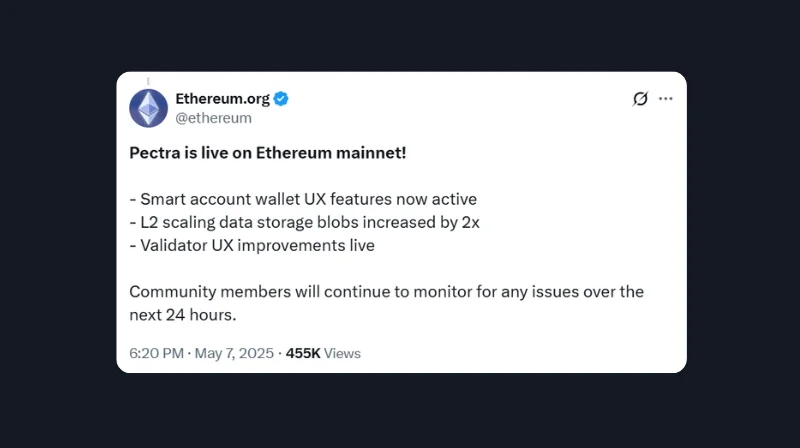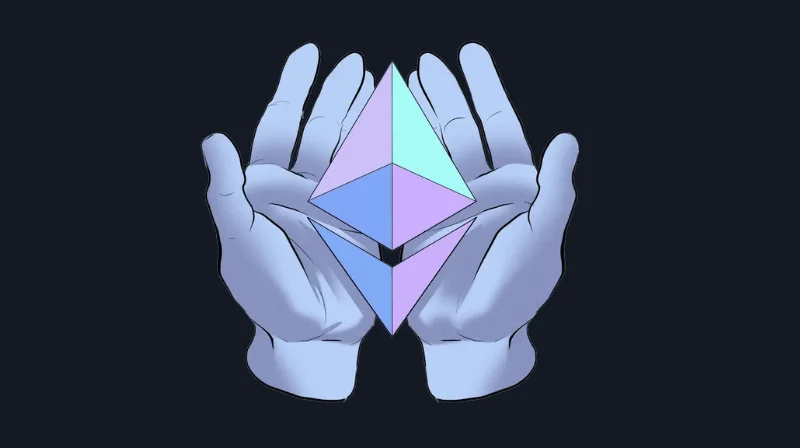Ethereum has accomplished the primary section of a serious software program improve known as Pectra, marking a big change to how the community handles accounts, staking, and knowledge processing.
The rollout comes over a yr after Ethereum’s earlier main replace—referred to as Dencun—and continues the undertaking’s shift towards bettering how the blockchain scales and operates underneath elevated demand. Pectra introduces a variety of Ethereum Enchancment Proposals (EIPs), together with modifications to how wallets perform, how validators handle their stake, and the way knowledge is processed via the community.
While the improve is essentially technical, it’s anticipated to have an effect on a variety of customers and builders, particularly these engaged on Layer 2 networks and decentralised functions.
 Supply: Ethereum
Supply: EthereumWhat’s Pectra?
Pectra is the identify given to Ethereum’s newest onerous fork—a coordinated protocol replace that modifies the community’s guidelines. The improve was activated on Wednesday at 06:05 ET, with community finality confirmed shortly after at 06:18 ET.
It follows the Dencun improve of March 2024 and represents Ethereum’s subsequent step in bettering its infrastructure for each customers and builders.
The identify combines “Prague” and “Electra”, referring to future roadmap targets involving each the consensus and execution layers of the community.

 Supply: Ethereum
Supply: EthereumWhat’s new with this improve?
Pectra contains a number of key modifications:
Account Performance: The replace introduces EIP-7702, which permits normal person accounts to quickly behave like good contracts. This provides accounts extra flexibility with out requiring customers to modify to a brand new tackle format. It’s thought-about an early step towards full “account abstraction,” a long-term purpose that may enable extra programmable and user-friendly wallets.Validator Staking: EIP-7251 will increase the utmost stake per validator from 32 ETH to 2,048 ETH. That is meant to scale back operational overhead for big validators and permit them to consolidate a number of positions into fewer, bigger ones. It might additionally enhance staking effectivity.Information Availability: EIP-7691 will increase the variety of “blobs”—a kind of off-chain knowledge bundle launched in Dencun—from 3 to six per block. Blobs are used primarily by Layer 2 scaling options to decrease transaction charges. The change successfully will increase Ethereum’s knowledge capability for such networks.Different Enhancements: The improve additionally contains optimisations for validator deposit dealing with, historic knowledge entry, cryptographic operations, and execution-layer exits.
Every of those options was proposed, examined, and reviewed earlier than being included within the improve.

 Supply: Ethereum
Supply: EthereumWhat’s subsequent for Ethereum?
Builders are actually shifting their consideration to the following deliberate improve, referred to as Fusaka. Amongst its targets is increasing knowledge availability additional, together with assist for a function known as PeerDAS—a protocol designed to enhance how rollups entry and distribute knowledge.
Though Pectra will increase blob capability, builders say extra scaling enhancements will probably be wanted to maintain tempo with Layer 2 development. Some imagine Ethereum’s knowledge layer would require even bigger will increase in capability to keep away from congestion over time.
Within the meantime, Ethereum validators might have to handle larger bandwidth and storage calls for as a part of the trade-off for higher throughput. In accordance with researchers, making certain that the community stays decentralised while rising efficiency will proceed to be a serious space of focus.
Fusaka is anticipated to handle a few of these considerations, although no official timeline for its deployment has been introduced.








